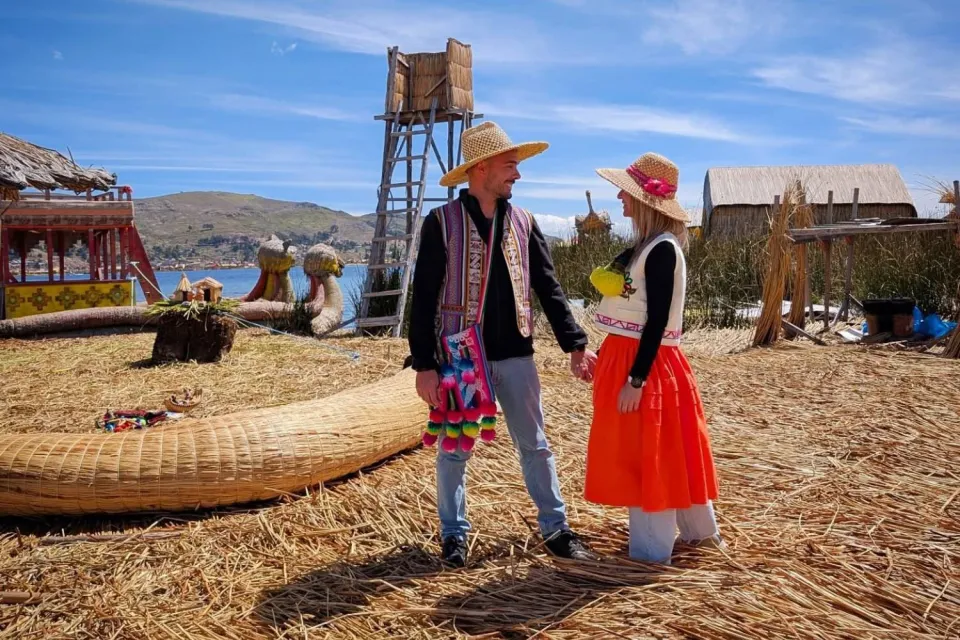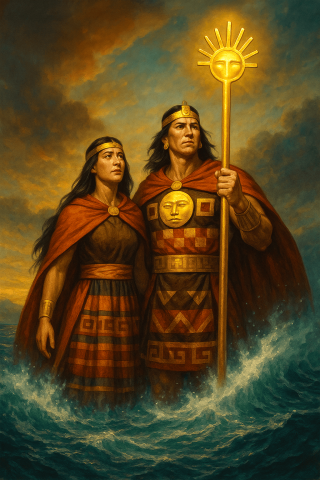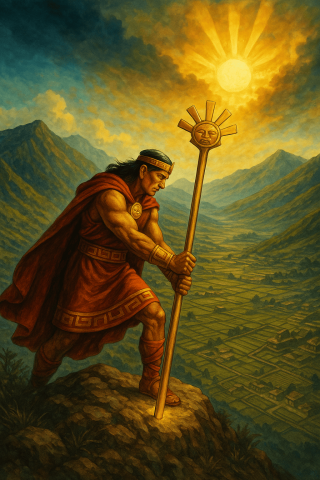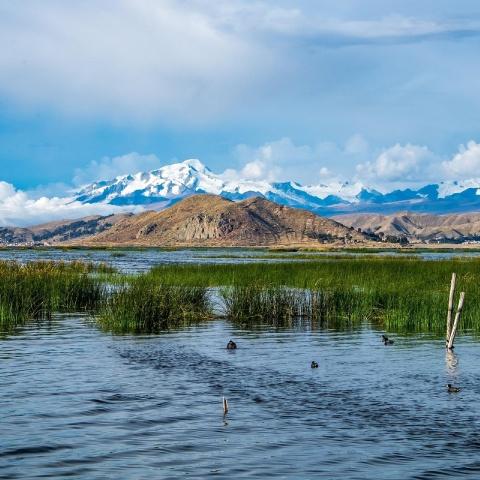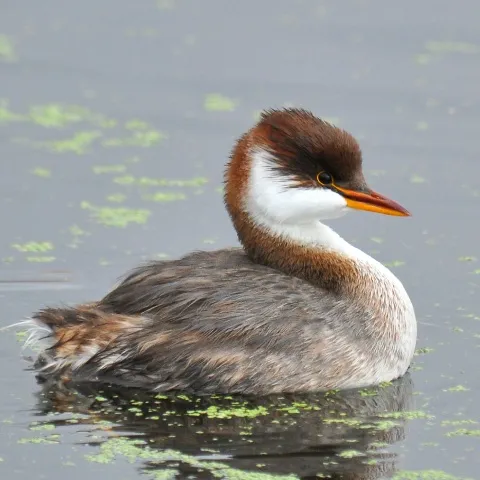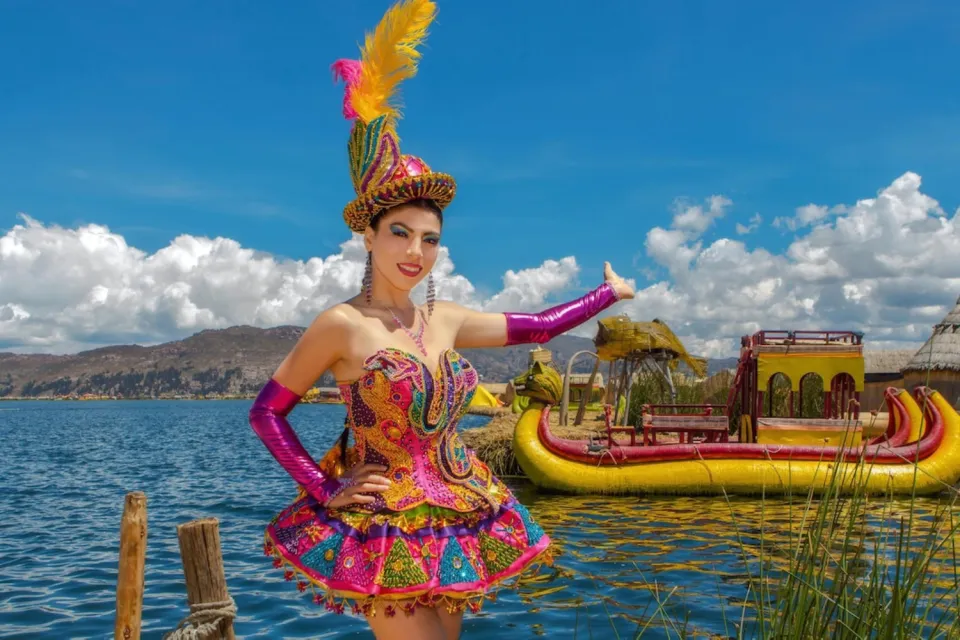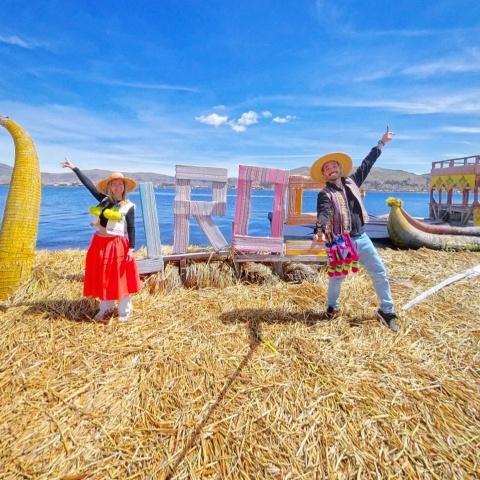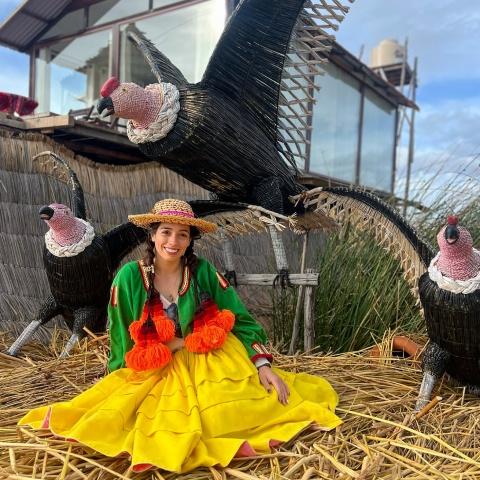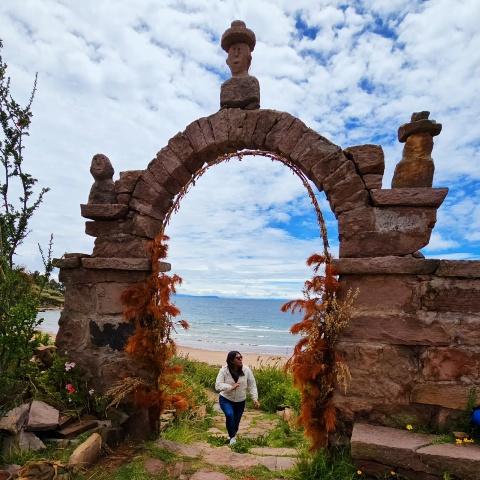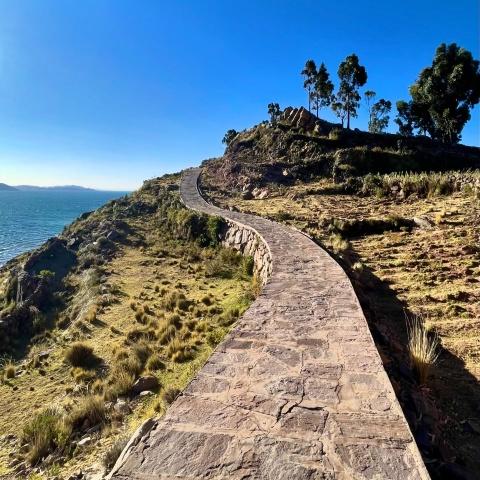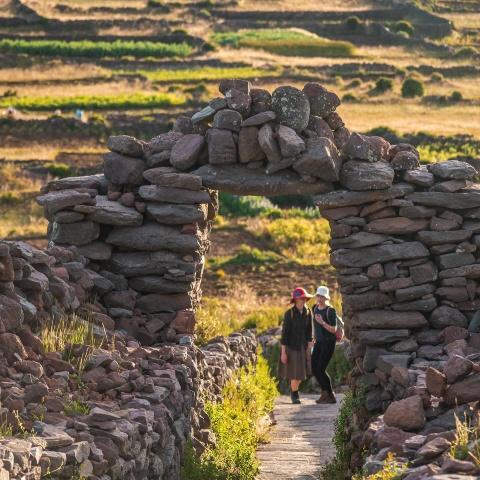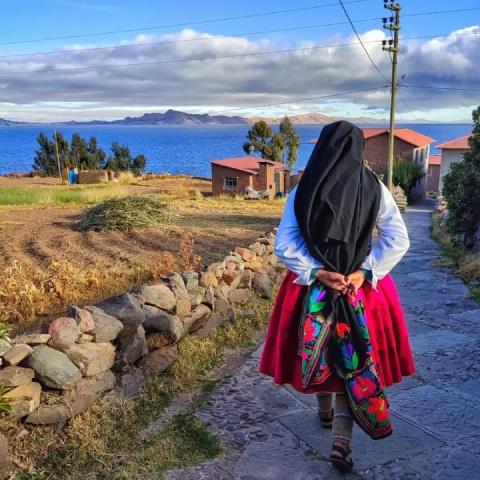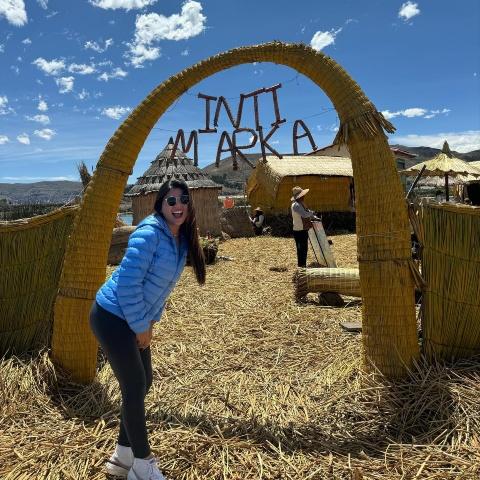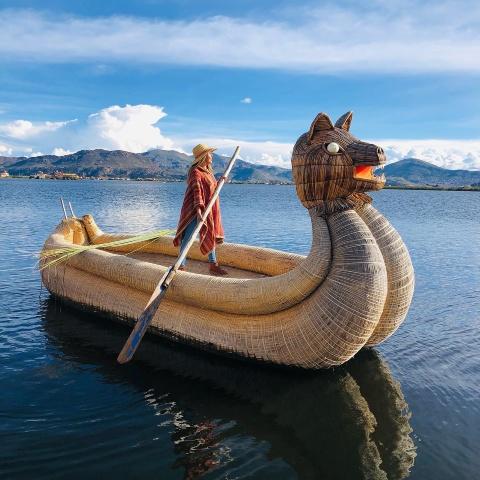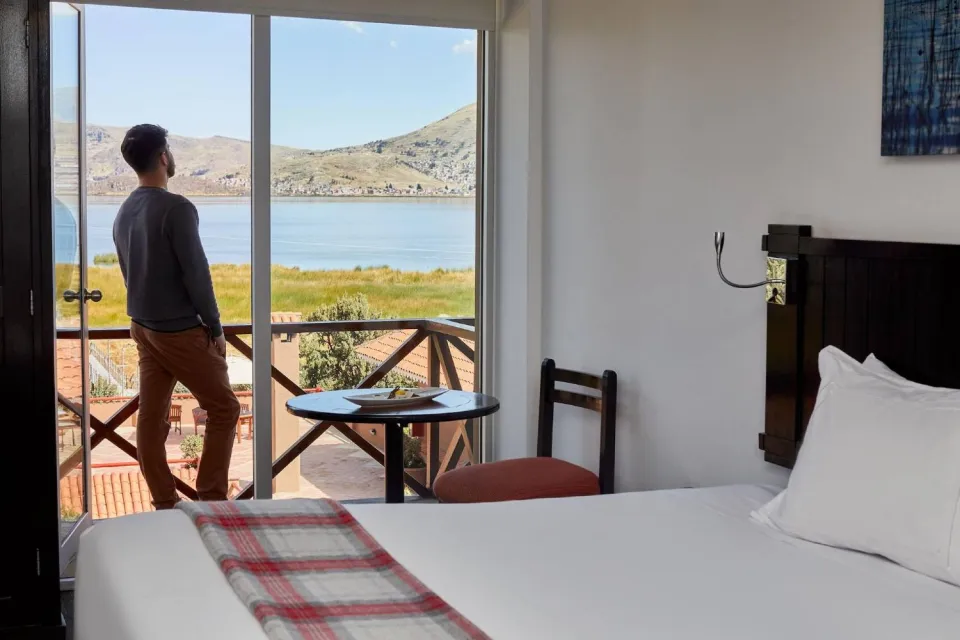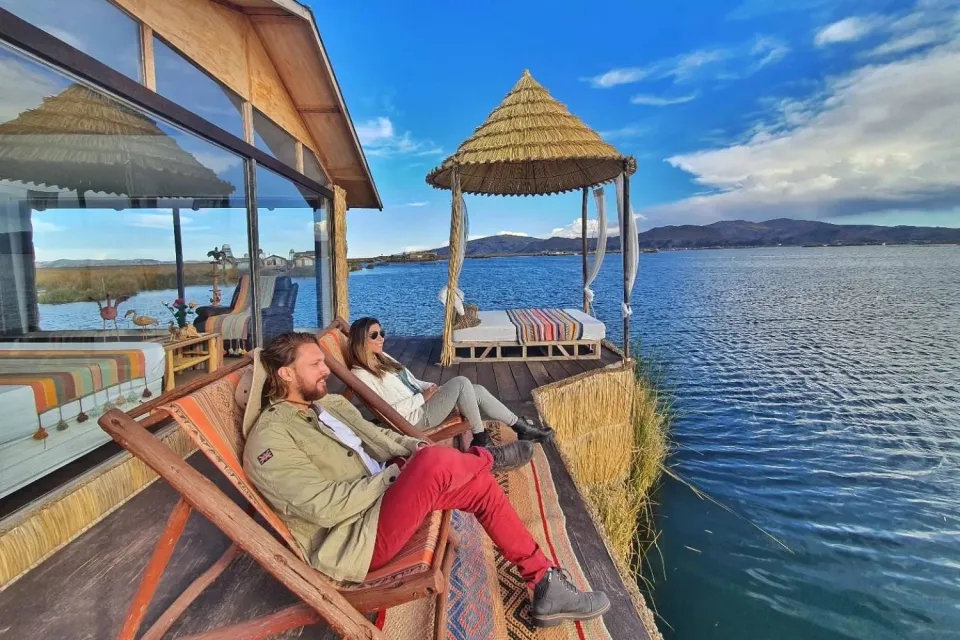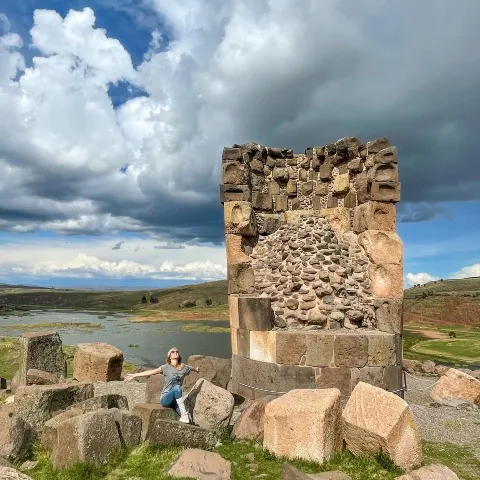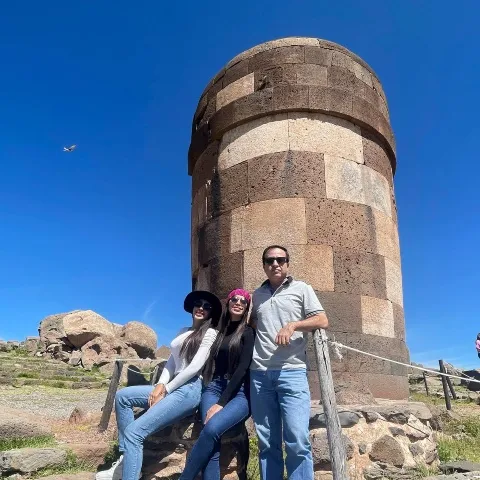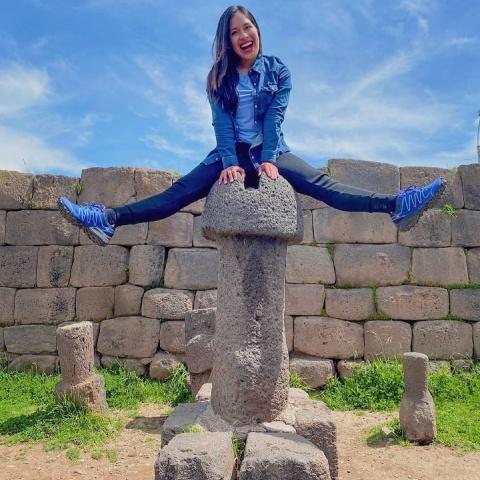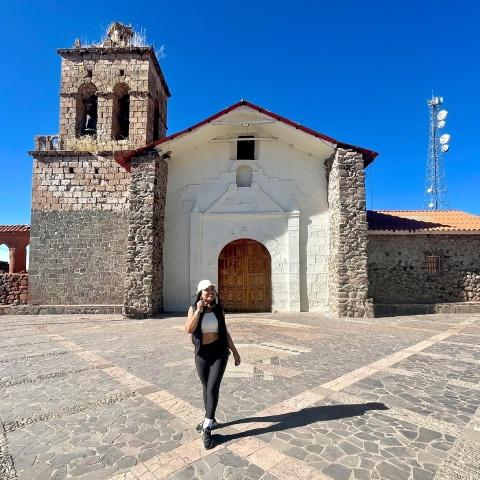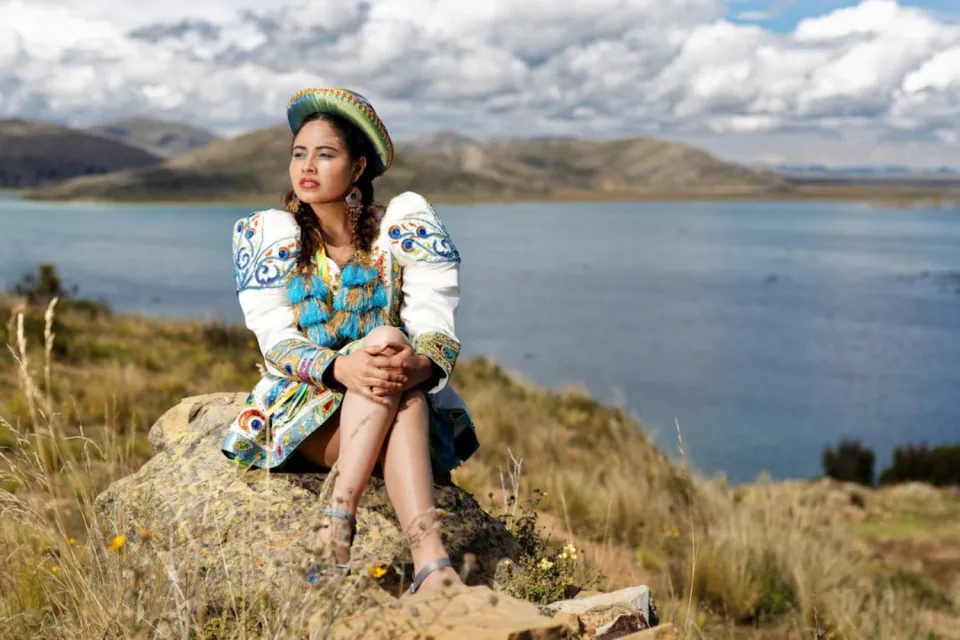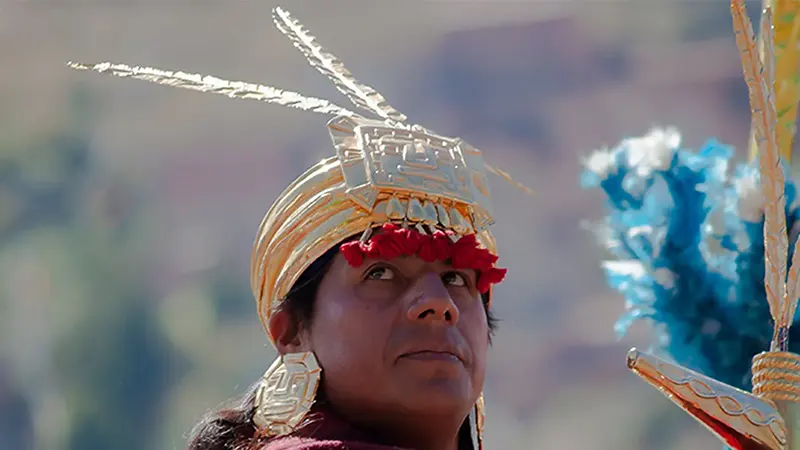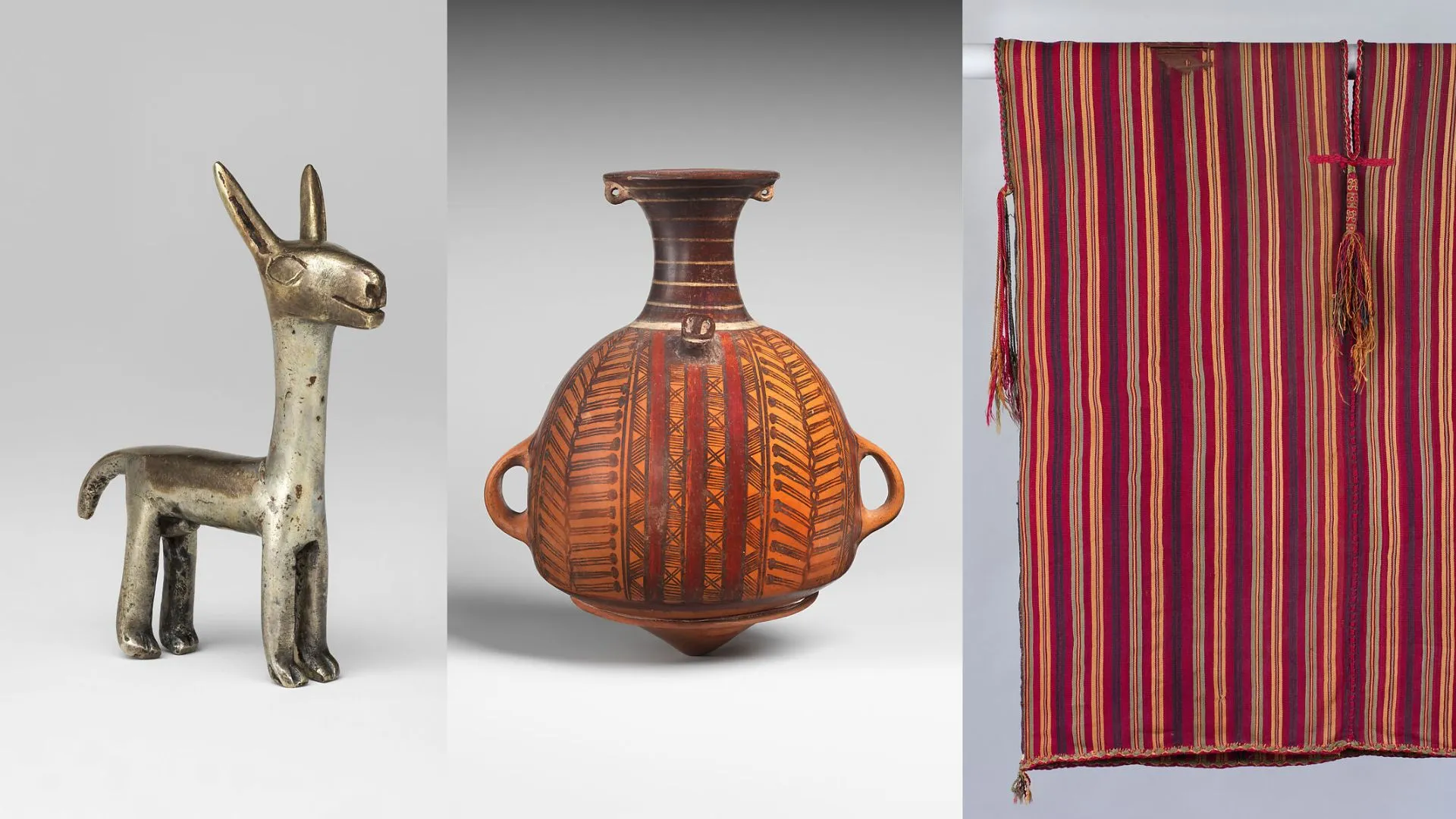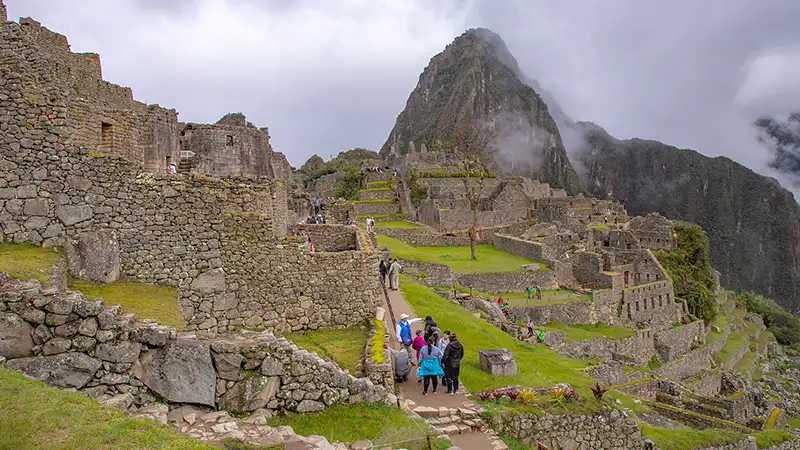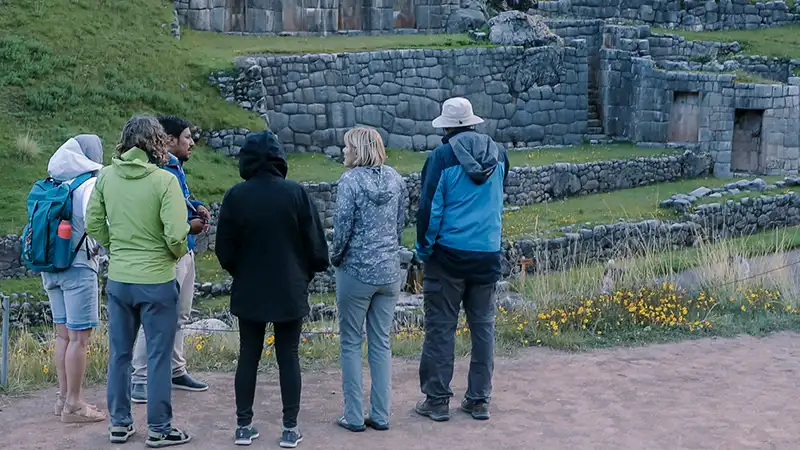How do entire communities survive on floating islands in Lake Titicaca? A vibrant man-made home. The floating islands, built with layers of totora reeds, are a marvel of ancient engineering that is still alive.
Located among the Andes at over 4000 m.a.s.l. in a sacred lake full of legends and biodiversity, you will discover an experience you will tell your whole life.
In this article, I will show you these fascinating islands, how to get to them and why they are a popular destination.
Meaning of Titicaca
Lake Titicaca is located in the territories of Peru and Bolivia. A place where tourists visit it for its history, ancestral culture and the natural beauty that surrounds it. It is a lake that is fed by 13 main rivers. The maximum depth of Titicaca reaches 283 meters. In addition, the lake is a closed basin with an ellipsoidal shape, but that's not all, it keeps a secret in the meaning of its name.
- In Aymara, “Titi means Puma and “K'aca” means Rock. Together they form “Puma de roca”, in reference to a sculpture carved on the Island of the Sun.
- In Puquina, “Titi” means Sun.
- In Quechua, “Qaqa” means Rock or Hill. Together they form “Rock of the Sun”, linked to the temple dedicated to the Sun God.
But what attracts even more attention are its floating islands and all the history that surrounds it. Lake Titicaca in Peru has islands, peninsulas and beautiful beaches that you should know. It is fed by the rivers Ramis, Huancané, Coata, Ilave and Suches.
Islands in Titicaca Lake:
- Amantani Island is the largest, with a circular shape and 9.28 km².
- Taquile Island (or Intika) is 5.72 km².
- Soto Island is elongated and covers 2.6 km².
- Yuspique Island covers 3.30 km².
- Anapia Island is also part of the Peruvian side.
History of Lake Titicaca
First inhabitants near Lake Titicaca
The formation of the altiplano lands is inferred to have begun in the Paleozoic period due to epirogenic movements that uplifted the mountain ranges. The creation of the lake may have occurred an average of 7 million years before, during the Cenozoic era.
10,000 years ago B.C. C., the first settlers arrived in the lake basin, and they took refuge in caves. They also hunted camelids and small animals for food. Their way of life persisted until 3,500 B.C. where something changed. They began to sow crops, and with that the villages grew and so did pastoralism.
Then they mastered the art of pottery, architecture and metallurgy. Thus, the following cultures arose:
- The Qaluyo: They left the first traces of public architecture. It is known that they were a people that connected through barter with nearby cultures. At that time, the hands made Cusipata and Chiripa style pottery. Other pieces have influences of the jungle cultures
- The Pukara: They emerged between 250 BC and 400 AD. They had the “Puquina” language that resounded strongly to the north of what is now Puno. They also sculpted new deities such as: figures with staffs, faces that radiated like suns, and beings that carried in their forms attributes of felines, birds, fish and snakes. Among them stood out a sacrificing character, firm with his trophy.
- Tiwanaku III: Meanwhile, in the territory that is now Bolivia, the Tiwanaku appeared between 100 A.D. and 400 A.D., with their Aymara language. They were close to the Pukara. After this society was influenced by the iconography of the Pukara, which were transferred to Tiwanaku. They built a cultural bridge that still lasts in time.
The conflict of the first villages before the Incas
Hundreds of years ago, villages lived on the shores of Lake Titicaca, but there was no peace. Villages fought each other for control of the land.
Society was divided into two large groups. To the north, the Hanansaya-Alasaa dominated. To the south, the Urinsaya-Cusiparte ruled.
Each corner of the lake had its own history. To the north, in the plains of Pukara and the Ramis River, lived the Collas. To the east, the Omasuyus built their villages near the water. To the west, the Lupacas built their home, led by their chief “Cari”.
In the south, near the Desaguadero River, the Pacaqes followed their cacique “Guarani”. Further south, the Carangas prospered. And to the northeast, near Lake Poopó, were the Charcas. Finally, in the mountains of southern Bolivia, the Kallawayas (they were like doctors in their time) cared for their land and traditions.
In the time of the Incas
Everything changed in the year 1430. The Inca Viracocha arrived in the Collasuyo looking to expand his kingdom. He decided to confront the brave “Cari”, leader of the Lupacas, in the southwestern islands. Viracocha won. Then they took the capital Hatun Colla and made a pact with them and returned to Cusco.
Years later, in 1471, the resistance returned. The people of the altiplano fortified hills like Llallahua, Asillo and Arapa. They wanted to regain their freedom. However, the Inca Tupac Inca Yupanqui led a large army and subdued them again. With the help of the Carangas, he reached the Charca territory. He captured the leader of the Lupacas and took him to Cusco as a prisoner.
A sacred lake
The Incas not only conquered these lands, they also venerated Lake Titicaca. For them, it was a sacred place. They built temples and tombs for their leaders on the shores of the lake. Ordinary people rested under large stones near their homes.
Legends of Lake Titicaca
The legend of Manco Capac and Mama Ocllo
The legend tells the origin of the Inca Empire through Manco Capac and Mama Ocllo, children of the Sun God, who were sent with a divine mission: to teach men to live in harmony and bring wisdom to the Andean tribes.
According to tradition, Inti, the Sun God, concerned about the ignorance and barbarism of the people of the Andes, decided to send his children to Earth to civilize humanity. His purpose was clear: to instruct men in the art of agriculture, social organization and respect for the Inca gods.
Manco Capac and Mama Ocllo emerged from the waters of Lake Titicaca, carrying a golden rod. Their father instructed them to found a city where the staff would sink easily into the earth, a sign that the place was fertile and sacred.
Having become human, they walked northward and tried burying the rod in several places, but the earth would not yield.
Finally, they reached the Cusco valley, specifically the Huanacaure hill, where the rod sank without resistance. They took this as the divine sign and decided to establish there the capital of the future empire.
Once settled, Manco Capac taught the men to cultivate, build houses and live wisely. For her part, Mama Ocllo instructed the women in weaving, home care and the education of children.
Although this story contains mythical and fantastic elements, some researchers consider that it may have a real basis.
There are theories that state that a group of leaders would have migrated from the Lake Titicaca area to the Cusco valley to found a new empire: the Tahuantinsuyo.
Flora and fauna of Lake Titicaca Lake
Titicaca's flora, although not as diverse as its fauna, is home to at least 12 types of aquatic plants adapted to the high-altitude environment. The most emblematic is the totora, an essential plant for local communities, as it is used to build the floating islands and traditional boats that navigate the lake.
Other notable plants include green algae, which serves as food for several species of fish, and submerged aquatic plants, which provide shelter and nutrition for the k'arachi and such'e, two well-known fish in the region.
Outside the lake, on and around its shores, grow tall thatch, ichu, small shrubs and a variety of Andean crops such as potato, quinoa, oca and barley, cultivated by local communities.
In contrast, the fauna of Lake Titicaca is surprisingly diverse. More than 350 species of waterfowl have been recorded, including the pato chancho and grebes.
As for fish, about 90% are endemic species, that is, they only exist in this lake. Among the most representative are the such'e and k'arachi, although non-native species such as trout have also been introduced.
Also living in the water is the famous Lake Titicaca frog (Telmatobius culeus), known for its large size and ability to absorb oxygen through its skin. Other aquatic animals include the Titicaca grebe, an endangered diving bird, and the seahorse, which is known for its large size and ability to absorb oxygen through its skin.
In the lands near the lake it is common to find Andean mammals such as the Andean fox, wild guinea pigs, field mice and vizcachas, chinchilla-like rodents that inhabit the rocky areas.
Climate of Lake Titicaca
Lake Titicaca is characterized by a cold and dry climate, with two distinct seasons, typical of the Andean region.
- Rainy season (December to April): During this season, the lake experiences frequent rains and some thunderstorms. Temperatures usually range from 1°C to 15°C, creating a cool and humid environment.
- Dry season (May to November): During this season, days are sunny and intense solar radiation is experienced. Temperatures vary between 15°C and 20°C during the day, but nights are very cold, with temperatures that can drop below 0°C.
The best time to visit the floating islands of Lake Titicaca is during the dry season, when the weather is more stable.
In this season, you will be able to enjoy clear skies and warmer temperatures, which will make your experience on the lake much more pleasant.
How many islands does lake titicaca have?
Lake Titicaca is known for its more than 40 islands, both floating and terrestrial. Some of the best known islands include:
Floating Islands of the Uros.
Lake Titicaca's floating islands are one of its main tourist attractions. These islands are home to the Uros, one of the oldest cultures in the Americas, even predating the Incas.
The islands are built with totora, an aquatic plant that is layered one on top of the other. The layers in contact with water decompose, so new layers of fresh totora must be added to keep the islands afloat.
The Uros depend on fishing and hunting for their livelihood, and some also make handicrafts and textiles from alpaca wool. Here, visitors can experience tourism and learn about the customs and traditions that the Uros still preserve.
Taquile Island
Taquile Island is a small and quiet land island with only 2,200 inhabitants. Its highest point is about 4,050 meters above sea level, from where you can enjoy spectacular views of the Cordillera Real of Bolivia.
The island is famous for its cultural heritage, including Inca terraces and ancient ruins. In addition, the Taquile community has been recognized by UNESCO for its weaving techniques, which are part of the intangible cultural heritage of humanity.
The island's cool climate favors agriculture, and it is common to see the inhabitants fishing in the traditional way.
Amantani Island
Amantani Island is the largest island in Lake Titicaca. Known as the island of love, it offers breathtaking scenery. Like Taquile Island, it has important Inca ruins, such as Pachamama and Pachatata.
On this island you can also experience experiential tourism, participating in activities such as textile making and agricultural and livestock work. The island has a rural atmosphere, where local life is still very much connected to ancestral traditions.
These islands, along with other smaller ones, make Lake Titicaca a unique destination to explore the history, culture and local life of the Andean people.
What to do in Lake Titicaca?
Lake Titicaca offers a wide variety of activities, from cultural experiences to adventure sports. Here we tell you about some of the highlights:
Visit the floating islands
Get up close and personal with the lifestyle of the communities that inhabit these islands made of totora reeds. Discover their customs, taste their delicious traditional food and learn about their ancestral link to the lake.
Kayak or totora reed boat tour
Explore the lake by kayaking or in the traditional totora reed boats. Many locals offer these rides that allow you to enjoy the scenery in a unique and sustainable way.
Boat ride
From the port of Puno, you can take boats that will take you around the different islands of the lake. Each has its own cultural identity and unique attractions.
Trekking on islands such as Taquile and Amantaní
If you like walking, you can hike along the cobblestone paths of these islands. When you reach the top, spectacular panoramic views await you, perfect for taking unforgettable photos.
How to get to Lake Titicaca
To get to Lake Titicaca, you must first get to the city of Puno, which is the closest city to the lake. Here I explain how to do it from the main cities:
1. Arrival to the city of Puno
How to get to Lake Titicaca from Lima?
From Lima, the capital of Peru, you can get to Lake Titicaca in two ways:
- Plane: You can take a flight from Jorge Chavez International Airport in Lima to Inca Manco Capac Airport in Juliaca. The flight takes about 1 hour and, from Juliaca, you will take a 45-minute drive to Puno.
- Bus: You can also opt for a bus trip from Lima to Puno. This trip takes approximately 20 hours. I recommend you to ask about the services offered by the buses to make sure you travel comfortably.
How to get to Lake Titicaca from Cusco?
This is a very frequent question among travelers. From Cusco, you have several options to get to Lake Titicaca:
- Bus: The bus trip from Cusco to Puno takes about 7 hours. There are comfortable buses that pass through picturesque scenery and offer a pleasant experience along the way.
- Train: If you prefer a quieter and more scenic trip, you can take the train from Cusco to Puno. The journey takes about 10 hours and is famous for its beautiful scenery along the way.
- Guided Tour: You can also take a guided tour on the famous Ruta del Sol, which takes you along several tourist spots between Cusco and Puno. In addition, there are packages such as the Peru Highlights Tour with Inca Trail of 10 days and 9 nights, in which you will enjoy the best tourist destinations in Peru.
2. Getting to the Lake Titicaca area
Once you arrive in Puno, the city is located just 10-15 minutes by cab or local transportation from Lake Titicaca.
From Puno, you can easily access the lake's tourist spots, such as the Uros and Taquile Floating Islands, by boats or tourist boats departing from the port of Puno.
Where to stay in lake titicaca?
Staying in Lake Titicaca can be a magical experience, with options ranging from boutique hotels to family-run lodges on native islands. Here I present you with some alternatives that you might love:
Casa Andina Premium Puno
Located on the shores of Lake Titicaca, this hotel combines comfort with exceptional panoramic views. Many of its rooms feature private balconies from which you can gaze out over the lake. It also has a private dock that facilitates access to water excursions.
You can also enjoy its restaurant, where you will savor typical dishes of the region and some of the most popular specialties of Peru.
Uros Titicaca Lodge or Amaru Marka Uros
This is a more rural and authentic option, located on the floating islands of the Uros. Built with totora reeds and wood, the lodge offers an experiential tourism experience in full harmony with nature.
The rooms are comfortable and blend in perfectly with the environment. Here you can participate in activities such as totora reed boat rides, artisanal fishing and bird watching.
Titicaca Lodge
Located on a private island in the lake, Ttilaka Lodge offers a unique experience combining luxury and tradition. Its rooms, decorated with local elements, provide comfort and authenticity.
You can enjoy excursions to nearby islands, guided hikes and cultural activities. In addition, the lodge's restaurant serves exquisite dishes prepared with fresh local products.
Uros Amaru Marka Hostel
This simpler but very cozy lodge is located on one of the floating islands of the Uros. It offers an experience close to experiential tourism, where you can actively participate in artisanal fishing, making handicrafts and preparing typical dishes with a local family.
The rooms, built with totora reeds, maintain a warm and comfortable atmosphere that adapts perfectly to the lake environment.
Other attractions near Lake Titicaca
Chullpas of Sillustani
The Chullpas de Sillustani are impressive pre-Inca burial towers located on a plateau on the shores of the Umayo lagoon, about 35 km from the city of Puno.
These cylindrical structures were built by the Kolla culture to bury their elites, and stand out for their sophisticated architecture, considered even more advanced than many Inca constructions.
To explore Sillustani is to immerse yourself in a mystical environment, surrounded by nature and silence. The beauty of the landscape, combined with the historical richness of the site, makes this visit an unforgettable experience, especially at sunset, when the sunlight tinges the chullpas and the waters of the lagoon with gold.
Chucuito: The temple of fertility
Only 18 km from Puno is Chucuito, a picturesque colonial town that is home to one of the most unique attractions of the altiplano: the Temple of Fertility. This enigmatic archaeological site, also known as Inca Uyo, stands out for its set of phallic sculptures carved in stone, which have generated multiple interpretations about rituals related to fertility in pre-Hispanic times.
Visiting Chucuito is not only an opportunity to discover this curious cultural legacy, but also to enjoy the tranquility of a town full of history, cobblestone streets, colonial architecture and spectacular views of Lake Titicaca.
Tips for your visit
Plan in advance every detail of your trip to make the most of this unique experience. Here are some essential recommendations:
- Acclimatize for a few days: Lake Titicaca is located at 3,812 meters above sea level, a considerable altitude that can cause altitude sickness. It is advisable to arrive in advance and take a couple of days to acclimatize. This way you will be able to better enjoy the activities in the following days.
- Dress in layers: During the day, temperatures can be warm, but at night they drop sharply. Wearing layered clothing will allow you to easily adapt to these changes.
- Bring a solar charger: If you want to capture every moment, make sure you have enough power in your cell phone. A solar charger will be your best ally, especially in areas with limited access to electricity.
- Stay hydrated: Hydration is key to better cope with the symptoms of altitude. Always carry a reusable water bottle with you and drink constantly.
- Avoid heavy meals the first few days: During acclimatization, avoid very heavy or greasy meals, as they may cause stomach upset. Opt for light meals until your body adapts.
- Wear non-slip slippers: If you plan to visit the floating islands -made of totora- or trekking on islands such as Taquile or Amantaní, good non-slip slippers will offer you greater safety and comfort.
- Try coca leaves: Tea or chewing coca leaves is a very effective traditional remedy to prevent or alleviate the symptoms of altitude sickness. You will find it in almost all lodges or local markets.
- Avoid smoking and alcohol: During the first few days, it is best to avoid smoking and alcoholic beverages, as they can intensify the effects of altitude sickness.
- Respect local cultures and traditions: Be respectful of the lifestyles and customs of the communities you visit. Avoid teasing or attempts to modify their ways of life; remember that you are a guest.
- Carry cash (preferably in soles): In many of the islands and communities there is no access to electronic payments. Bring cash in local currency to buy handicrafts, souvenirs or try a typical snack.
Is lake titicaca worth visiting?
Definitely yes. Lake Titicaca is not only the highest navigable lake in the world, but also one of the most fascinating cultural and natural destinations in South America. This mystical place, shared between Peru and Bolivia, combines breathtaking landscapes, living ancestral traditions and unforgettable experiences. On the Peruvian side, you can explore the floating islands of the Uros, where the inhabitants build their homes with totora reeds and keep alive their ancient customs. You can also visit Taquile or Amantaní, islands that offer hikes with spectacular views and total immersion in experiential tourism.
In addition, the deep blue waters of the lake, surrounded by Andean mountains and clear skies, create a perfect environment for taking stunning photographs, kayaking and enjoying moments of total disconnection. Whether you are looking for adventure, history, culture or simply tranquility, Lake Titicaca has something special to offer.
Visiting it is not just a tourist destination, it is a transformative experience.
Frequently Asked Questions
- How deep is lake titicaca?
Lake Titicaca has a maximum depth of 283 meters, and its average depth is 107 meters.
- Where is Lake Titicaca in South america?
Lake Titicaca is located between Peru and Bolivia. This shared lake has 56% of its surface in Peruvian territory and 44% in Bolivian territory.
If you wish to visit it from Peru, it is located in the department of Puno, where you can find many floating islands.
- Is lake titicaca bioluminescent?
No, Lake Titicaca is not bioluminescent. This phenomenon normally occurs in tropical seas or coastal lagoons, but not in Lake Titicaca.
- How large is lake titicaca?
Lake Titicaca is the highest navigable lake in the world and one of the largest in South America. Its dimensions are as follows:
- Total area: Approximately 8,372 km².
- Maximum length: About 190 km.
- Maximum width: Up to 80 km.
- Height above sea level: Approximately 3,812 meters.
- Maximum depth: About 283 meters.
- How many rivers empty into lake titicaca?
Lake Titicaca is fed by 13 large rivers and 12 small rivers. Some of the main rivers that empty into the lake are:
- Rio Ramis (Peru)
- Rio Costa (Peru)
- Rio Suches (Peru-Bolivia border)
- Rio Huancané (Peru)
- Rio Llave (Peru)
- Rio Suchezani (Bolivia)
- Why is lake titicaca important?
Lake Titicaca is of great cultural, historical, ecological and economic importance:
- Cultural and spiritual: It is considered the place of origin of Inca mythology, with Manco Capac and Mama Ocllo as its main figures, which gives it a sacred character. The communities that inhabit the lake, such as the Quechua, Aymara and Uros, maintain ancestral traditions related to the lake.
- Historical and archaeological: There are archaeological remains underwater and on the islands, such as pre-Inca temples, agricultural terraces and ceremonial objects
- Ecological: It is a habitat for endemic species such as the Titicaca giant frog and the Titicaca silverside, in addition to being a unique and fragile ecosystem due to its wetlands, reed beds, and its biodiversity adapted to the high altitude.
- Economic: The lake is a source of resources for artisanal fishing, and its tourism, especially related to floating islands and experiential tourism, is a vital part of the local economy.
- What is lake titicaca known for?
Lake Titicaca is famous for being the highest navigable lake in the world, for being the cradle of Andean civilizations, for its floating islands, for its experiential tourism and for its breathtaking scenery.
- Can you swim in lake titicaca?
Yes, it is possible to swim in Lake Titicaca, but you must keep in mind that:
The water is very cold, with temperatures ranging between 10°C and 14°C even in the warmer months, and in winter, it can get below 9°C.
There are no official bathing areas or surveillance, so some tourists seek the quieter areas for swimming.
Due to the altitude, lung capacity is reduced, making swimming more strenuous than usual.
It is recommended to swim in calm areas, accompanied by friends, and not to stay too long due to the cold.
- How big are the floating islands in lake titicaca?
Most of the floating islands in Lake Titicaca are not very large, and their average size varies between 500 and 1,000 m², which is equivalent to the size of a soccer field or even less.
The largest islands, which are communal, can be up to 2,500 m².
- Are there seahorses in lake titicaca?
Yes, Lake Titicaca is home to a unique species of seahorse: the Andean seahorse (Hippocampus ingens).
This seahorse is endemic to the region and is found nowhere else in the world. They are 25 cm long and have colors ranging from yellow to green, which allows them to camouflage with aquatic plants. Their habitat is in the deepest and calmest areas of the lake.
This species is vulnerable due to overexploitation and loss of habitat due to pollution and climate change.
- Are there sharks in lake titicaca?
No, there are no sharks in Lake Titicaca. It is a freshwater lake located more than 3,800 meters above sea level, so its environmental characteristics are not suitable for sharks.
Although prehistoric shark fossils have been found in the region, they are not related to the current fauna of the lake.
- How cold is lake titicaca?
Lake Titicaca has cold temperatures throughout the year, with temperatures ranging from 10°C to 14°C in the warmer months, and in winter, the water can reach temperatures as low as minus 9°C.
- How far is lake titicaca from machu picchu?
Lake Titicaca is approximately 380 kilometers as the crow flies from Machu Picchu. However, the distance by road or train is greater due to the mountainous geography of the Andes. To get from Machu Picchu:
- By bus: The trip takes between 6 and 9 hours.
- By tourist train (such as the Andean Explorer): Approximately 10 hours.
- By plane: There are no direct flights to Puno, but you can fly to Juliaca, which is only 1 hour drive from Puno.

